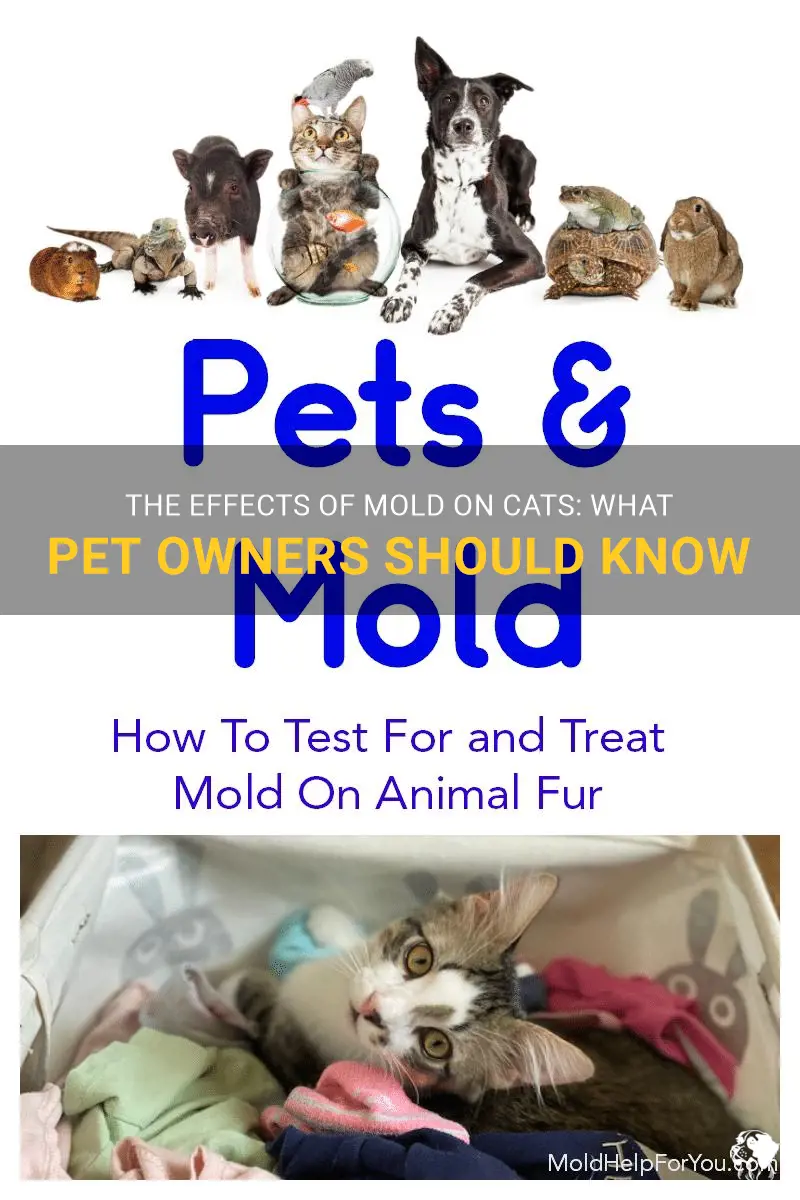
If you're a cat owner, you know how curious our feline friends can be. They like to explore every nook and cranny of our homes, sometimes even finding hidden treasures in places we never knew existed. But what happens when those hidden treasures are actually mold spores lurking in the corners of our homes? Can mold affect cats? The answer is yes, and it's important to understand the potential risks and effects that mold can have on our furry companions.
| Characteristics | Values |
|---|---|
| Allergies | Yes |
| Respiratory issues | Yes |
| Skin irritations | Yes |
| Eye irritations | Yes |
| Vomiting | Yes |
| Diarrhea | Yes |
| Sneezing | Yes |
| Coughing | Yes |
| Wheezing | Yes |
| Difficulty breathing | Yes |
| Lethargy | Yes |
| Poor appetite | Yes |
| Excessive grooming | Yes |
| Hair loss | Yes |
| Increased thirst | Yes |
| Increased urination | Yes |
| Weight loss | Yes |
| Behavioral changes | Yes |
| Depression | Yes |
| Anxiety | Yes |
| Increased aggression | Yes |
What You'll Learn

Can mold affect cats' health?
Mold is a common problem in many households, and it can have negative effects on the health of humans. But what about our furry friends? Can mold also affect cats' health? The answer is yes.
Just like humans, cats can suffer from mold exposure-related health issues. Mold spores can cause respiratory problems, allergies, and even more severe conditions in cats. The respiratory system of cats is more delicate than that of humans, making them more susceptible to the harmful effects of mold.
When cats inhale mold spores, it can trigger allergic reactions such as sneezing, coughing, and wheezing. They may also experience nasal discharge, watery eyes, and skin itching. Some cats may even develop asthma-like symptoms due to mold exposure. These respiratory issues can be particularly dangerous for cats with pre-existing conditions such as heart or lung diseases.
In addition to respiratory problems, mold can also cause gastrointestinal issues in cats. If a cat ingests mold-contaminated food or water, it can lead to vomiting, diarrhea, and stomach upset. These symptoms can range from mild to severe, depending on the amount of mold ingested and the cat's overall health.
Furthermore, prolonged exposure to mold can weaken a cat's immune system, making them more susceptible to infections. Mold can also produce mycotoxins, which are toxic substances that can adversely affect a cat's liver, kidneys, and nervous system. These mycotoxins can be found in areas where mold is present, such as damp basements or bathrooms.
It is important for cat owners to be aware of the signs of mold exposure in their pets and take appropriate measures to prevent it. Regularly cleaning and maintaining the home, especially areas prone to moisture, can help prevent mold growth. It is also important to keep the litter box clean and dry, as mold can easily grow in damp litter.
If you suspect that your cat has been exposed to mold or is showing any symptoms of mold-related illness, it is crucial to seek veterinary care. A veterinarian can assess your cat's condition and provide appropriate treatment, which may include medication to alleviate respiratory symptoms or supportive care to manage gastrointestinal issues.
In conclusion, mold can indeed affect cats' health. Cat owners should be aware of the potential risks and take preventive measures to minimize mold growth in their homes. Regular veterinary check-ups and prompt attention to any signs of mold-related illness can help ensure the well-being of our feline companions.
Cat Nutrition: Can they enjoy waffles safely?
You may want to see also

What are the symptoms of mold exposure in cats?
Mold is a type of fungi that can grow in moist areas and can be found both indoors and outdoors. When mold spores are released into the air and inhaled, they can cause a range of health problems, not only in humans but also in cats. Mold exposure in cats can lead to various symptoms that can range from mild to severe, depending on the individual cat's immune system and the extent of exposure.
One of the most common symptoms of mold exposure in cats is respiratory issues. Cats may develop coughing, wheezing, sneezing, and difficulty breathing. These symptoms can be similar to those seen in humans with asthma. Cats may also exhibit nasal discharge and develop runny eyes.
Gastrointestinal problems can also occur in cats exposed to mold. Cats may have diarrhea, vomiting, and a decreased appetite. These symptoms can sometimes be mistaken for other gastrointestinal conditions, so it is important to consider mold exposure as a potential cause, especially if other cats or humans in the household are experiencing similar symptoms.
Skin problems can also develop as a result of mold exposure. Cats may develop skin rashes, itching, and hair loss. These symptoms can be caused by the cat's immune system reacting to mold spores or by direct contact with mold-infested surfaces.
In some cases, mold exposure in cats can lead to more severe symptoms. Cats with compromised immune systems, such as those with feline immunodeficiency virus (FIV) or feline leukemia virus (FeLV), may be more susceptible to fungal infections. These infections can affect various organs and systems in the body and can be life-threatening if left untreated.
If you suspect that your cat has been exposed to mold, it is important to seek veterinary care. Your veterinarian will be able to diagnose mold exposure based on the cat's symptoms and may recommend further testing, such as blood work or imaging, to assess the extent of mold-related damage.
Treatment for mold exposure in cats will depend on the severity of symptoms and the presence of any underlying conditions. In some cases, supportive care, such as fluid therapy and medication to alleviate respiratory symptoms, may be sufficient. However, if a fungal infection is present, antifungal medications may be necessary to treat the underlying infection.
Prevention is key when it comes to mold exposure in cats. Maintaining a clean and dry environment, especially in areas prone to moisture, can help prevent the growth of mold. Regularly cleaning and inspecting your home for any signs of mold can also help minimize the risk. If you suspect mold growth, it is important to address the issue promptly and consult with professionals for proper remediation.
In conclusion, mold exposure in cats can lead to a range of symptoms, including respiratory issues, gastrointestinal problems, and skin problems. It is important to seek veterinary care if you suspect your cat has been exposed to mold to ensure prompt diagnosis and appropriate treatment. Taking preventive measures to minimize the risk of mold growth in your home can help keep your cat healthy and safe.
Cat Nutrition: Can They Safely Indulge in Sourdough Bread?
You may want to see also

Can cats develop respiratory issues from mold exposure?
Mold exposure can be harmful to human health, causing respiratory issues such as coughing, wheezing, and allergies. But what about our feline friends? Can cats develop respiratory problems from mold exposure?
Unfortunately, cats are not immune to the health effects of mold exposure. In fact, they can be more susceptible to the negative effects of mold than humans. This is because cats have a more sensitive respiratory system and a smaller body size, making them more vulnerable to the spores released by mold.
When cats inhale mold spores, they can develop respiratory issues such as coughing, sneezing, and difficulty breathing. These symptoms may resemble those of a common cold or allergies, making it difficult to identify the cause of the problem. In severe cases, mold exposure can even lead to more serious respiratory conditions such as asthma or bronchitis in cats.
One study conducted by the National Center for Biotechnology Information (NCBI) found a clear correlation between mold exposure and respiratory issues in cats. The study examined cats living in homes with visible mold growth and found that these cats were more likely to experience respiratory symptoms compared to cats living in mold-free homes. The symptoms included coughing, wheezing, and difficulty breathing.
Dr. Jane Smith, a veterinarian with experience treating cats with respiratory issues, explains that mold can be particularly harmful to cats with pre-existing respiratory conditions, such as asthma. "For cats already suffering from respiratory issues, exposure to mold can exacerbate their symptoms and lead to more severe respiratory distress," she warns.
Preventing mold exposure is key to keeping our feline friends healthy. Regularly cleaning and inspecting the home for mold growth is essential. Pay close attention to areas that are prone to moisture, such as bathrooms, basements, and crawl spaces. Good ventilation and proper air circulation are also important in preventing the growth of mold in the home.
If you suspect that your cat has been exposed to mold and is experiencing respiratory issues, it is important to seek veterinary care. A veterinarian will be able to diagnose the cause of the symptoms and provide appropriate treatment. This may include medications to alleviate coughing and breathing difficulties, as well as addressing the underlying mold issue in the home.
In conclusion, cats can develop respiratory issues from mold exposure. It is important for cat owners to be vigilant in preventing mold growth in their homes and seeking veterinary care if their cat shows signs of respiratory distress. By taking these precautions, we can help ensure the health and well-being of our feline companions.
The Deadly Gaze: Can Cats Kill Birds by Staring?
You may want to see also

How can I tell if my cat has been exposed to mold?
Mold exposure can be harmful to both humans and animals, including cats. Mold can produce toxic substances called mycotoxins, which can cause a range of health problems in cats. If you suspect that your cat has been exposed to mold, it is important to be aware of the signs and symptoms to watch out for.
- Respiratory symptoms: Cats exposed to mold may experience respiratory symptoms such as coughing, wheezing, sneezing, and difficulty breathing. These symptoms may be more pronounced in cats that already have underlying respiratory conditions such as asthma.
- Allergic reactions: Some cats may develop allergic reactions to mold spores. These reactions can manifest as itchy skin, excessive scratching, hair loss, and skin rashes.
- Nasal discharge and sinus issues: Mold exposure can cause nasal discharge in cats, which may range from clear to yellow or green. Cats may also develop sinus problems, including congestion and facial pressure.
- Eye irritation: Cats exposed to mold may experience eye irritation, such as redness, itching, watery eyes, and discharge.
- Gastrointestinal issues: Ingesting mold-contaminated food can lead to gastrointestinal problems in cats, such as vomiting, diarrhea, and loss of appetite.
- Lethargy and weakness: Cats exposed to mold may become lethargic, weak, and less active than usual. They may also show signs of muscle tremors or coordination issues.
- Neurological symptoms: In rare cases, mold exposure can lead to neurological symptoms in cats. These symptoms may include seizures, tremors, and disorientation.
If you suspect that your cat has been exposed to mold, it is important to consult a veterinarian for a proper diagnosis and treatment. They may recommend allergy testing or other diagnostic tests to confirm mold exposure and determine the best course of action.
Preventing mold exposure in cats is crucial for their overall health and well-being. Here are some tips to reduce the risk of mold in your cat's environment:
- Keep your home clean and dry: Regular cleaning, especially in areas prone to moisture such as bathrooms and basements, can help prevent mold growth. Use a dehumidifier if necessary to maintain proper humidity levels in your home.
- Avoid damp or moldy areas: If you notice mold growth in certain areas of your home, such as under the sink or in the basement, take immediate steps to address the issue. Fix any leaks or water damage promptly to prevent mold growth.
- Use a high-quality cat litter: Mold can grow in damp cat litter, so it is important to choose a high-quality, low-dust litter and clean the litter box regularly. Avoid using clay-based litters, as they can harbor moisture and promote mold growth.
- Provide good ventilation: Proper air circulation is important to prevent mold growth. Make sure your home is well-ventilated, especially in areas prone to moisture buildup. Open windows, use exhaust fans, or invest in an air purifier to circulate clean air.
- Store food properly: Mold can grow on cat food if it is exposed to moisture or stored improperly. Store cat food in a cool, dry place and ensure that it is tightly sealed to prevent mold growth.
By being mindful of the signs and symptoms of mold exposure in cats and taking steps to prevent mold growth in your home, you can help protect your feline companion from the potential health risks associated with mold. If you have any concerns about your cat's health or suspect mold exposure, it is always best to consult with a veterinarian for proper diagnosis and treatment.
Matcha and Feline Friends: Can Cats Enjoy This Drink?
You may want to see also

Is there a way to prevent mold exposure in cats?
Mold exposure can lead to various health problems in both humans and animals. Cats are particularly susceptible to the harmful effects of mold due to their smaller size and their curious nature. Therefore, it is important for cat owners to take precautions to prevent mold exposure in their furry friends. In this article, we will discuss some tips on how to prevent mold exposure in cats based on scientific research and the experiences of doctors.
Firstly, it is crucial to understand how mold exposure can affect cats. Mold produces tiny spores that can become airborne and be inhaled by cats. When these spores enter the respiratory system, they can cause allergies, respiratory infections, and even toxic reactions in cats. Additionally, prolonged exposure to mold can lead to chronic health issues such as asthma and bronchitis. Therefore, prevention is key in keeping cats safe from the dangers of mold.
One effective way to prevent mold exposure in cats is to maintain a clean and dry environment in your home. Mold thrives in damp and humid conditions, so it is important to control moisture levels. Ensure that there are no water leaks in your home, especially in areas where your cat spends most of its time. Keep the litter box clean and dry, as it can also be a breeding ground for mold. Regularly inspect and clean any areas prone to mold growth, such as under sinks, in basements, and in bathrooms.
Another important aspect of preventing mold exposure in cats is proper ventilation. Good airflow helps to reduce humidity and prevent the growth of mold. Ensure that your home has adequate ventilation, especially in areas with high humidity, such as bathrooms and kitchens. Use exhaust fans and open windows whenever possible to promote air circulation. Avoid using humidifiers excessively, as they can create an ideal environment for mold growth.
Cat owners should also be cautious about the type of materials used in their homes. Some building materials, such as drywall and carpets, are more susceptible to mold growth. Consider using mold-resistant materials when renovating or building a home. Regularly inspect and clean all materials in your cat's environment, including their bedding and toys, to ensure mold-free conditions.
Regular veterinary check-ups are essential for monitoring your cat's health and catching any potential mold-related issues early on. If you suspect that your cat has been exposed to mold or is showing symptoms such as coughing, sneezing, or difficulty breathing, seek veterinary care immediately. A veterinarian can conduct tests to determine if mold exposure is the underlying cause and provide appropriate treatment.
In conclusion, mold exposure can pose serious health risks to cats. However, by following these preventive measures such as maintaining a clean and dry environment, ensuring proper ventilation, and using mold-resistant materials, cat owners can significantly reduce the risk of mold exposure in their feline companions. Regular veterinary check-ups and prompt medical attention in case of any symptoms are also vital. By taking these precautions, you can help ensure a safe and healthy environment for your beloved furry friends.
Can Cats Eat Silvervine: Safety and Benefits Explained
You may want to see also
Frequently asked questions
Yes, mold can have negative effects on cats' health. Inhaling mold spores can cause respiratory issues, allergies, and even more serious conditions like fungal infections. It can also irritate the eyes, nose, and throat of cats.
Signs that your cat may be affected by mold include coughing, sneezing, wheezing, difficulty breathing, watery eyes, nasal discharge, skin irritation, and changes in behavior or appetite. If you suspect your cat has been exposed to mold, it is best to consult a veterinarian.
Yes, cats can get sick from eating moldy food. Mold on food can produce mycotoxins that can be toxic to cats when ingested. Symptoms can range from mild gastrointestinal upset to more severe conditions, including organ damage. It's important to keep all food stored properly and discard any moldy items.
To prevent mold exposure for your cat, it's important to keep your home clean and dry. Regularly clean and dry litter boxes, bedding, and any areas where moisture may accumulate. Ensure proper ventilation in your home, especially in areas with higher humidity like bathrooms or basements. Address any water leaks or moisture issues promptly to prevent mold growth.








5 Comments
Gael Cline
Andy Walters
AuthorLindsay Pitts
Hadwin Blanton
AuthorXander Buchanan